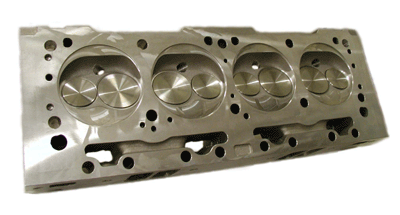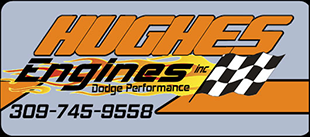|
|
#7---Choosing Heads: Aluminum vs. Iron (Which Ones Do You Need?)
Some basic guidelines on how to choose heads | 1/1/2014 |
With the current availability and popularity of aluminum heads for both Big and Small Blocks, the question of which to use (iron or aluminum?) is more pertinent now than in the recent past. Since we port, test, sell about an equal number of each and love both of them we can offer some unbiased opinions and information. With the number and types of aluminum heads now available, the Mopar racers need to understand all of the quirks about them and terms used with them.
There are several types or levels of heads available and there is a lot of confusion over what is what. This confusion is in part created by the terms "bolt-on" and "stock replacement". They are used indiscriminately and interchangeably, and no one has stepped forward to either clarify or classify them. We will try!
A "stock replacement" head is one that has the stock location of the ports and rocker arms and these original components will along with the rocker covers and other odd brackets will attach like they did on the original iron heads. No spacers, oil lines or other adapters are required.
"Bolt-on" can generally be interpreted, with cylinder heads, to mean that they will have head bolt holes located in the same "location" as the stock ones. So they will "bolt-on" with the correct bolts, which may or may not be the same as stock, usually not. It does not mean that they are a "stock replacement" head and you should not expect any OEM pieces to fit. This "bolt-on" type head will be a race type head and have the ports raised from the original location and require special intake manifolds or spacers and Special exhaust components, and many times special rocker arms and maybe even external oil lines.
The difference in cost between the two is very high too, as many who have called our shop can testify. They have been sold as so-called stock replacement heads that "bolt-on" and need many expensive parts to complete the job. That takes them out of the "stock replacement" group no matter what you call them, you can put lipstick on a pig, but it's still a pig. And no, we don't know of any lower cost way out of that dilemma, except to send the heads back and get what you wanted in the first place.
We are dealing with two different types of heads from a performance stand point too! A stock replacement type head must have the port locations in the same position as the stock head, so the manifolds etc. will attach. This feature has drawbacks because raising the ports is one of the best ways to improve air flow, but with that alteration comes the special manifolds, spacers, headers, rockers etc. putting the head into the raised port bolt-on group. In our shop we consider the following heads to be true "stock replacement" heads:
 Small Block Small Block
Edelbrock RPM aluminum
#61779
M/P P4529269 iron
M/P '785 aluminum
M/P '310 aluminum
'574 factory iron
'596 factory iron
'974 factory iron
Big Block
Edelbrock RPM aluminum #60829, #60929, #5090 #5093
M/P P4529992 Stage V iron
M/P '311 383/440 aluminum
We often get requests to compare these "stock replacement" heads to heads that are not on this list, in other words raised port, "bolt-on" heads. This is unfair and misleading; they are not apples to apples comparison. The stock replacement head are just that, a stock replacement head in a high performance version. The raised port, "bolt-on" head is a head designed for racing. If you need a "bolt-on" raised port head why would you even care about a "stock replacement" head? On the other hand if you need a high performance, "stock replacement" head, buying the raised port "bolt-on" heads can be a expensive mistake.
Some of the raised port heads such as the Edelbrock VIctor and SUper Max Wedge Victors have "extended" intake surfaces so that stock type intake will fit. You could even bolt an OEM cast iron intake manifold on them.
As we always tell our callers, you must build your car/engine with a plan or a goal in mind. You can use horsepower, ET or money, they will all end up at the same point, but you must have a plan. If you are starting from scratch and need 750 or more horsepower and cost is not a problem go with the fully ported raised port bolt-on heads which should have the capability to develop the most power. Here we run into another problem. Some of the more popular raised port bolt-on heads barely out flow a set of, well ported, stock replacement heads. Check carefully before buying. Heads with ports in the stock locations can be ported to flow about the same amount of air whether they are iron or aluminum. Read that sentence again! All "stock replacement" performance aluminum heads are designed to develop more power than the iron heads they are replacing. However the gap between what was designed and what leaves the factory can be worlds apart.
When aluminum heads are cast there is a lot of core shift, more than with iron heads. That core shift ALWAYS reduces the air flow in the port. The question is how much flow is lost and is it significant in reaching your goal. We constantly check the "out-of-the-box" flow of heads that we are porting and find them to be down 15 to 30 CFM. The CFM from port-to-port will also vary 15 to 30 CFM in the same head (please refer the our Flow Bench section for further information).
In an effort to reduce manufacturing costs on ready-to-bolt-on heads, "finished" seat rings may be installed in the heads by pressing or driving. This procedure causes the seats to go out-of-round. We have seen them out-of-round 0.014" to 0.016". The limit should be 0.002" or less. Seats this far out of tolerance will cause hard starting, rough idle, and reduced power output. Originally, performance aluminum heads were designed for porting shops to finish and correct the manufacturing flaws before the head was installed. That way the problems of core shift and out-of-round seats never reached the end user.
Aluminum heads dissipate (get rid of) heat much faster than iron heads. The rapid heat loss from the combustion chamber results in reduced combustion chamber pressures (heat equals pressure); similar to the effect that lowering the compression ratio which lowers cylinder pressure. When switching to aluminum heads you MUST raise the compression ratio to prevent a power loss. This is a good opportunity for our customers to take advantage of our computer calculated compression ratio service. This software assures them of getting the maximum power out of their purchase; it's a no-charge service for our customers.
Aluminum heads will not automatically create more power than iron heads unless they flow more air and are installed on a higher compression ratio engine. In cases where you have a decent port job on a set of iron heads it is possible to bolt on a set of out-of-the box aluminum heads and lose power. Aluminum is automatically lighter but not faster. Yeah, yeah I've read all of those magazine articles that told you how they installed brand X widget and picked up 500 HP and 4 seconds in the 1/4 mile (we have even been the victim of these articles). What you must keep in mind is that those magazines and the writers (???) are paid by the advertisers, not by that $19.99 subscription you send in once a year. So you can expect that advertised products always look good even when they screw the test up and the "results" are not what they should be, (been there done that!). They are under a deadline and the rent has to be paid so the facts sometimes take a back seat. In some cases the engine would have produced more power with a set of well ported, iron heads, and at a lower price.
|
Quick Facts: Aluminum vs Iron
|
- Weight: Aluminum heads weigh about 45 to 50 lbs., a pair, less than iron heads
- Durability: "Ported iron heads can crack if the engine is badly over-heated". Yes this is true, but if the engine got that hot the aluminum head would have melted or been badly warped. The seat rings would have also fallen out, but the head might not crack. Anyone who lets his engine get that hot deserves to buy new heads or have an expensive repair bill
- Reparability: This is a trick question. Yes, aluminum heads are easier to repair if the damage is very bad and that is a good thing because they are much more fragile and more prone to damage than a hard, iron head
- Cost: Aluminum heads cost more, and then there may be the hidden cost of raising the compression ratio
- Airflow: You get very similar airflow results from ported, stock heads and "stock replacement" type heads. With raised port cylinder heads, the sky is the limit
- Power: Power depends on what you have to start with, or what else you plan to do to the engine. If you have low compression (9.5:1 or less) and are not going to change pistons or mill the heads to restore the cylinder pressure, save some money and go with the ported iron heads. If you are starting on a fresh engine with higher compression ratio pistons, want to lose some weight and the budget can handle it ---go ported aluminum. There is another power consideration; most of the aluminum heads have a closed combustion chamber which is far superior to the OEM heads with their open chamber design. However, if the piston is not at 0.000" deck, the chamber design has very little effect.
|
| If all this sounds like we don't like aluminum heads, the truth is quite the contrary. Aluminum heads are cleaner, easier to port and they look trick next to an iron head. If you make a mistake on an aluminum head, it is easy to fix. If you drop it on your toe it doesn't hurt as bad. Porting aluminum also keeps the shop cleaner, what's not to like? We just want you, our customer, to get the right cylinder heads, iron or aluminum. After all you, the customer, are the ones paying for this web-site, thanks for the help. |
|
|



